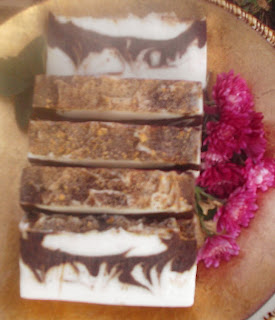Have you ever wondered if the colorants used in soap making are really natural? Me too! Here is an interesting article I found in my late night research. I am in love with dusting 24 kt. Gold Mica on my White and plain color soaps to add some bling and sparkle!
DYES, PIGMENTS, LAKES, MICAS
http://www.tkbtrading.com/content.php?content_id=13
"DYES: Drug Association (FDA) is the arm of the federal government which regulates the use of color additives in Food, Drugs and Cosmetics. "Natural" color additives are classified by the FDA as colors coming directly from plants or animals. The cosmetic grade natural colors are: annatto, carotene, carmine, caramel, henna. These natural colors are all dyes. There are also plenty of natural dyes which are not approved for use in cosmetics (but are fine in soap) such as turmeric, or chlorophyll.
PIGMENTS: Could be a Natural Dye derived from plants or animals, or could be a Coal Tar Dye, which is not natural.
Coal Tar Dyes have been shown to cause cancer in animals, and they are an irritant to some people.
LAKES: Iron Oxides, and similar mineral pigments are not, by FDA standards, "Natural", because they are not directly from plants or animals. Instead, they come from minerals.
While considered "natural" by consumers, cosmetic-grade pigments are all man-made in order to meet FDA approval.
Lake colors are always derived from the Coal Tar Dyes and therefore are never considered Natural.
MICA: Minerals formed in the earth
-----------------------------------------------------------------
What are Soap Colorants?
Oxides & Ultramarines: These are powdered pigments, made from oxidized metals such as iron and titanium. They occur naturally in the earth, but for cosmetic use it is much safer and less expensive to use manufactured versions. They are very commonly used in eye shadows and other cosmetics. For more info on titanium dioxide as an example, see Wikipedia article on Titanium Dioxide.
Micas: Micas are also powdered pigments, but are a bit more complex. They usually contain an oxide component, along with actual powdered mica mineral. Natural mica is basically a type of rock, that features thin glittery, flaky layers. This is combined with various oxides and some other ingredients (see INCI names in each mica color's description in our catalog) to create the variety of cosmetic mica colors (as well as micas for other applications). See also the Wikipedia article on Mica.
Cosmetic Clays: Also in powdered form, clays are found naturally around the Mediterranean Sea. Different metal compositions form the different colors and different reputed skin benefits. These create a slippery, lathery feel in soap and a softly colored and earthy yet shiny look.
Are these colorants natural? This is a much debated topic. Although the term natural has no legal definition in the U.S., our opinion is these are not natural colorants. They are synthesized and manufactured, not gathered or harvested. We feel the only natural colorants for soaps are spices and some botanicals. The problem with the latter is they tend to be very dull and earthy, with a limited range of color, and can often fade or change over time. So for a nice range of bright and (mostly) stable colors, our pigments and dyes are a safe, time-tested method of coloring soap."
--------------------------------------------------------------------------------
Cold Process Soap Usage Tips:
http://symphonyscents.com/catalog/index.php
"Micas: Some Micas can be used readily in CP soap, some are tricky, and some are not usable because they will fade out.
The best, most stable colors to use are: Copper, Gold Dust, Mocha Shimmer, Sunshine Yellow, and Tan Opal.
The tricky ones will not fade but may morph or change a bit: Coral, Pearl Mauve, Sea Foam, and Sparkle Pink.
The colors which will fade out in CP soap are: Emerald Green, Lavender, and Sapphire Blue.
Use about a teaspoon of mica for each pound of soap in your batch. Just add the mica directly to your base oils, blend thoroughly with a stick blender (or by hand) to incorporate. Make sure they are thoroughly blended or you will get clumps in your soap. Or, you can add the colorant at thin trace if desired.
Another method is to mix some mica in a tablespoon of oil and drizzle in the color to achieve the color that you desire.
Ultramarines and Oxides: These can be dissolved into water or oil. The yellow, chromium green and red oxides work much better when dissolved in oil; the others in water. Start with about 1/2 teaspoon per pound (1/4 tsp per pound for Red Oxide or Chromium Green Oxide). Mix with 1/2 tsp of hot water or room temp oil. Blend into your base oils, or add at trace. Lori prefers adding colorants (mixed in oil or water) directly to her base oils for single color soaps to insure complete blending of colors.
Cosmetic Clays: Use about 1/2 teaspoon per pound of soap. Drop right in with your base oils, or after mixing with lye water."
Fragrance Free Vegan Soap, one of my first with Gold Mica.
My first attempt with the swirl method (below). These are made with Coffee and Dark Chocolate in the center layer, and Honey Almond fragrance oil in the White layers, dusted with Cocoa powder and Gold Mica. Smells wonderful!


No comments:
Post a Comment